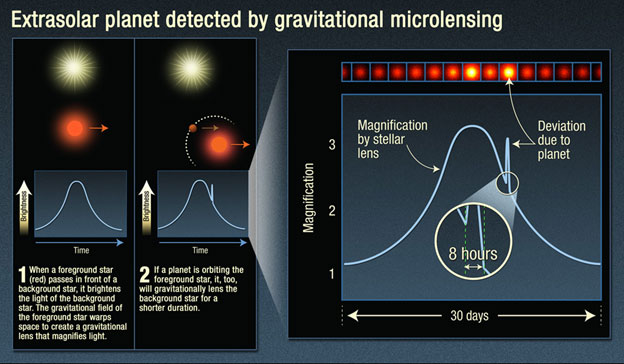Astronomers uncovered four new Earth-mass rogue planet candidates by searching for microlensing events observed with Kepler.

No longer part of any stellar system, rogue planets drift aimlessly through space after the tumultuous early stages of planet formation eject them. Now, using NASA’s Kepler telescope, astronomers have announced four new Earth-mass outcast planet candidates.
When a star or planet passes in front of a distant star, it acts like a magnifying lens to temporarily brighten the background star, an effect known as microlensing. Since rogue planets don’t have the luxury of a host star to reveal their presence, they are best detected via microlensing. The smaller the “lens,” the shorter the microlensing event; Earth-mass planets magnify background stars for a couple hours at most, which makes these microlensing episodes hard to find.
In the first search for rogue planets using a space-based observatory, a team lead by Iain McDonald (now at Open University, UK) used data from a two-month span of the rejuvenated Kepler mission, dubbed K2, to scavenge for microlensing events. K2 was not meant to look at the dense galactic bulge, so the team had to develop new methods to sift through the data. They found 27 microlensing events, five of them brand new. Four of these new events have the shortest duration of all their findings, lasting a little over an hour at most and hinting at the presence of Earth-mass rogue planets. The team presents the results in the July Monthly Notices of the Royal Astronomical Society.
The Hunt for Rogue Planets
Even though planets cause many microlensing events, most of these worlds are bound to a star – in fact, one of the newly discovered events shows the signature of a bound planet. Previously, astronomers knew of only five super short-lived microlensing episodes (including one we’ve reported previously) thought to be caused by low-mass rogue planets. McDonald’s team has almost doubled that number.

NASA, ESA, and K. Sahu (STScI)
Przemek Mro̒z (California Institute of Technology), a fellow rogue planet hunter, isn’t convinced that all of these planets are actually drifters. “Figuring out whether these objects are indeed free-floating or not is more tricky,” he says. It’s possible, he adds, that some of these planets might be orbiting far from their host star while remaining gravitationally bound. “Their microlensing signature would look like nearly identical to the signal expected from free-floating planets.”
While there’s always a chance that the four new microlensing events could indicate something less interesting, such as bound planets or stellar flares, the fact that they lasted such a short time suggests that free-floating planets are a serious contender. Ground-based observations are needed to confirm these events, but these findings present exciting evidence that an Earth-mass population of rogue planets might wander our galaxy.
“The new results from Kepler confirm our earlier studies based on ground-based OGLE observations that such low-mass (Earth-mass) free-floating or widely-orbiting planets are quite common in the Milky Way,” says Mro̒z. If these outcast earths are truly typical in our galactic neighborhood, future telescopes like Euclid and Nancy Grace Roman will be able to detect their signals easily.
 3
3









Comments
StanR
July 16, 2021 at 5:17 pm
Wouldn't a grazing transit by a large rogue planet have about the same light curve as a central transit by an earth-size rogue planet? Can the two be distinguished?
You must be logged in to post a comment.
Yaron Sheffer
July 18, 2021 at 5:02 pm
Yes, the two are indeed distinguishable. The light curve of a central transit has a flat bottom, while that of a grazing tansit has a curved bottom, since the latter case does not reach its "maximum potential" in opacity. (BTW, microlensing is about light amplification, not about eclipsing transits.)
You must be logged in to post a comment.
Tom Hoffelder
July 17, 2021 at 9:59 am
"I have seen the dark universe yawning
Where the black planets roll without aim-
Where they roll in their horror unheeded,
Without knowledge or luster or name."
(H. P. Lovecraft - 1918)
You must be logged in to post a comment.
You must be logged in to post a comment.